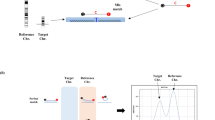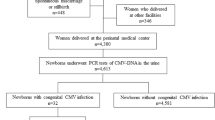Abstract
Purpose: To determine the optimal approach to the prenatal chromosome analysis of fetal urine from fetuses with bladder outlet obstruction.
Methods: Retrospective evaluation of traditional cytogenetic and interphase fluorescence in situ hybridization (FISH) analysis on fetal urine specimens from fetuses with bladder outlet obstruction.
Results: Traditional cytogenetic analysis was successful on 71 (95%) of 75 samples, and FISH was informative on 20 (65%) of 31 specimens. The combination of traditional cytogenetic analysis and FISH yielded a 96% diagnostic success rate. The mean turnaround time was 8 days (range 5–14) for traditional cytogenetic analysis and 1.6 days (range 1.0–4.0) for FISH. Chromosome abnormalities were detected in 6 (7.9%) of 76 pregnancies.
Conclusion: Traditional cytogenetic analysis achieves a high success rate (95%) and is superior to FISH for chromosome evaluation of fetal urine. However, FISH, when informative, can complement traditional cytogenetics as it will expeditiously rule out common trisomies in fetuses with bladder outlet obstruction.
Similar content being viewed by others
Main
The management of a fetus with a prenatally diagnosed bladder outlet obstruction has undergone a dramatic change in the past two decades as our understanding of the natural history of this condition has improved. Left untreated, neonatal death due to pulmonary hypoplasia and renal dysplasia commonly occur, especially in those pregnancies in which oligohydramnios and prenatally diagnosed hyperechogenic renal parenchyma or subcortical cysts are identified.1 The most important advance in the treatment of fetuses with this condition involves intervention in the form of in utero vesicoamniotic shunting for carefully selected fetuses. Criteria for selection of candidates for fetal bladder shunting include those with favorable prognostic signs based on a thorough ultrasound examination evaluating the appearance of the fetal kidneys and ruling out other congenital malformations, sequential fetal urine electrolyte analysis, β2-microglobulin concentration, and chromosome analysis.2,3 If favorable sonographic, biochemical, and cytogenetic results are obtained and the fetus is at an appropriate gestational age to consider in utero intervention (usually between 16 and 32 weeks), expeditious placement of a vesicoamniotic shunt is recommended to bypass the bladder outlet obstruction, relieve the increased pressure in the urinary tract which has led to vesicoureteral reflux and hydronephrosis, and allow amniotic fluid to accumulate to reduce the risk or severity of pulmonary hypoplasia.
In experienced hands, fetal urine can be aspirated easily under ultrasound guidance in cases of bladder outlet obstruction.4 In these cases, a distended megalocystic bladder is often present. In addition, as most amniotic fluid is derived from fetal urine, amniocentesis is often not possible because of oligohydramnios from the obstructive uropathy.
Although several authors have reported the use of fetal urine for prenatal cytogenetic analysis, most publications have been isolated case reports.5,6 In addition, although a recent review regarding the management of fetal obstructive uropathy stressed the importance of chromosome analysis for fetuses with bladder outlet obstruction and noted that this could be performed by either amniocentesis or chorionic villus sampling (CVS), the authors did not include the option of cytogenetic analysis from fetal urine.3 We present our experience involving the chromosome analysis of 75 fetal urine specimens from fetuses with bladder outlet obstruction, including 31 evaluated by interphase fluorescence in situ hybridization (FISH). This investigation provides information on the efficacy and reporting time of cytogenetic and FISH evaluation from fetal urine and the optimal approach to the laboratory evaluation of fetuses with bladder outlet obstruction.
MATERIALS AND METHODS
A systematic review was performed of the Genzyme Genetics database from January 1995 to April 2001 for fetal urine specimens submitted for analysis. The laboratory requisitions accompanying these samples were checked to confirm that the samples represented fetal urine and not amniotic fluid from fetuses with obstructive uropathies. In all cases, the referring obstetrician noted explicitly on the requisition form that the sample was fetal urine and the indication for prenatal chromosome analysis was bladder outlet obstruction. Information on gestational age, sample volume, cytogenetic results, FISH results, and turnaround time was queried. Information on the amount of in utero amniotic fluid, including whether oligohydramnios was present and whether other associated fetal abnormalities were identified, was not available in most cases. Similarly, it was not known whether the fetal urine samples were obtained specifically because the amniotic fluid volume was diminished. Analysis of amniotic fluid specimens, chorionic villus samples, and fetal blood specimens from fetuses with prenatally diagnosed bladder outlet obstruction was not included in this investigation.
Cytogenetic and interphase FISH analysis on fetal urine was performed according to standard techniques, using the same protocols as for amniotic fluid.7 In-house FISH probes8 were used with early samples, with the AneuVysion probe set (Vysis, Inc., Downers Grove, IL) used since January 1998. These FISH probes are designed to detect numerical aberrations of chromosomes 13, 18, 21, X and Y.
RESULTS
Seventy-nine fetal urine specimens were initially identified in the database. Four cases were excluded from the investigation because of test cancellation prior to attempting analysis. These tests were canceled because alternate sources of cytogenetic information, two amniotic fluid specimens and one case each of chorionic villi and fetal ascites, were available for chromosome analysis. Of interest, one of these four canceled cases was determined to be trisomy 21 on cytogenetic study of amniotic fluid. Therefore, 75 specimens were included in the investigation of cytogenetic and FISH success rates on fetal urine.
Traditional cytogenetic analysis was attempted on all 75 specimens. FISH was attempted on 31 samples. The determination to perform traditional cytogenetic analysis, FISH, or both was based on the referring physician's request. Traditional cytogenetic analysis was successful on 71 (95%) of 75 samples with no cell growth in four specimens. FISH evaluation was successful on 20 (65%) of 31 specimens. In one case, traditional cytogenetic analysis was unsuccessful but FISH was informative, allowing us to obtain chromosome information which would not have otherwise been available. We were able to obtain chromosome information (cytogenetics and FISH) on 72 (96%) of 75 fetal urine specimens. Of the 11 unsuccessful FISH studies, all were due to insufficient cells.
The mean gestational age was 20.3 weeks (range 15–32), and the mean sample volume was 22.5 mL (range 4.5–50). The mean turnaround time, from receipt of the specimen in the laboratory until a final result was reported, was 8 days (range 5–14) for traditional cytogenetic analysis and 1.6 days (range 1–4) for FISH. Ninety-four percent (29/31) of the FISH results were available within 48 hours.
Chromosome abnormalities were detected in 6 (7.9%) of 76 pregnancies with bladder outlet obstruction. There were two males with trisomy 21, one female with trisomy 13, one male with an interstitial deletion of chromosome 13, one male with an unbalanced translocation involving additional unidentified material on the short arm of chromosome 20, and one male with an apparently balanced de novo reciprocal translocation. Eighty-six percent of samples were from male fetuses. Chromosome information was obtained from either cytogenetic analysis, FISH evaluation, or chromosome study of the products of conception in 76 (96%) of 79 pregnancies with bladder outlet obstruction. This includes the four cases that were excluded from the cytogenetic and FISH portion of the investigation due to cancellation of fetal urine testing because alternate tissue sources for cytogenetic evaluation were available. In three instances, no cytogenetic information was obtained. Mosaicism was not encountered in any sample analyzed. The breakdown of chromosome complements in fetuses with prenatally diagnosed bladder outlet obstruction and known karyotypes is presented in Table 1.
DISCUSSION
Chromosome abnormalities are found in a significant proportion of fetuses with prenatally diagnosed bladder outlet obstructions. Qureshi et al.8 identified aneuploidy in 5 (4.5%) of 110 fetuses with obstructive uropathy. In a series involving 53 patients with genitourinary malformations, cytogenetic abnormalities were identified in 5 (9.4%).9 Both Nicolaides et al.10 and Brumfield et al.11 identified aneuploidy in 23% of their fetuses with bladder outlet obstruction involving 39 and 30 fetuses, respectively. Our investigation revealed a 7.9% prevalence of aneuploidy (Table 1).
There are two major disadvantages involving FISH evaluation of fetal urine specimens. First, the current probes are unable to rule out deletions, translocations, mosaicism, and chromosome abnormalities other than the common aneuploidies. Second, there is a limited success rate since 35% of samples in this study were uninformative because of insufficient cells. When successful, the rapid turnaround time is the most advantageous aspect of FISH as results were available in <48 hours from receipt of the sample for 18 (90%) of 20 specimens in this study. However, our data revealed that three of the six chromosome abnormalities would not have been identifiable with FISH (Table 1). Based on this information, it may be prudent to await a full karyotype prior to performing a bladder shunt procedure. Other techniques that can provide rapid cytogenetic results when amniotic fluid is unavailable include CVS (either transabdominally or transcervically) and fetal blood sampling. Both these techniques have the advantage of providing complete cytogenetic information as opposed to FISH, which is most commonly used to detect numerical abnormalities of chromosomes 13, 18, 21, X and Y. However, fetal blood sampling is associated with a 1.4% risk of fetal loss12 and confined placental mosaicism is known to occur in approximately 1% of CVS samples. In addition, drainage of fetal urine to evaluate electrolyte values and determine the prognosis for renal function is a crucial step in the evaluation of a fetus with bladder outlet obstruction. By obtaining both urinary electrolyte information and cytogenetic analysis from fetal urine, a second needle insertion, as required for transabdominal CVS and fetal blood sampling, can be avoided.
Another advantage of FISH analysis following the diagnosis of bladder outlet obstruction is the rapid identification of fetal gender. The determination of fetal gender is important in the evaluation of a fetus with obstructive uropathy. Often, sonographic visualization of external genitalia is hindered because of oligohydramnios. Therefore, reliance on the cytogenetic results for determining the sex of the fetus is necessary. The predominant etiology for bladder outlet obstruction in male fetuses is posterior urethral valves. This condition is most amenable to fetal intervention in the form of vesicoamniotic shunting. Female fetuses comprise a minority of cases involving bladder outlet obstruction. In our series, we identified a female karyotype in 14% of samples. A previous series reported that 20% of fetuses with bladder outlet obstruction were female. In that series, when a female fetus was affected, there was a significantly increased risk of an extrarenal anomaly or a complex genitourinary tract malformation.11 Counseling for the parents regarding pregnancy outcome is altered with the knowledge that their fetus with a bladder outlet obstruction is female. This is due to the higher rate of associated defects including cloacal abnormalities and the possibility of conditions such as the megacystis-microcolon-hypoperistalsis syndrome. Data on amniotic fluid volume and other associated anomalies were not obtained in this investigation. However, this information is critical in addressing prognosis in cases of fetal bladder outlet obstruction.
In the current study, when results were informative from both traditional cytogenetic analysis and FISH from the fetal urine sample, there was complete agreement of cytogenetic and FISH results (19/19) without any false-negative or false-positive FISH results. The application of FISH to fetal urine was first reported in 1994.5
Approximately 5% to 10% of amniotic fluid samples will have uninformative FISH results. The reasons for an uninformative result are predominantly technical artifact, insufficient cells, and maternal cell contamination, especially with blood-contaminated samples or from fetuses with oligohydramnios.13 In cases of potential maternal cell contamination, the reporting of normal female results could lead to false-negative results or incorrect sex determination. There were 11 uninformative FISH samples in our investigation; all were due to insufficient cells to perform the analysis. This is likely due to a lower cell concentration of transitional cells in fetal urine than the cell concentration found in amniotic fluid. There was no evidence that the FISH failure rate was related to gestational age or to transport time as all samples were received in the laboratory within 48 hours of being drawn. It is clear that the success rate for obtaining an informative FISH result from fetal urine is significantly less than the success rate achieved with amniotic fluid.
The American College of Medical Genetics has recommended that irreversible therapeutic decisions not be based on FISH results alone but should include chromosome analysis and/or other medical information.14 In addition, FISH should not be used as a stand-alone test but, whenever possible, as an adjunct to traditional cytogenetic analysis. However, the combination of a structural fetal anomaly and an abnormal FISH result should allow for definitive management decisions.15,16 Therefore, the presence of an abnormal FISH result in conjunction with a megalocystic bladder, oligohydramnios, and abnormal-appearing kidneys may be useful to many couples in making the decision to continue or terminate the pregnancy. Conversely, expeditious vesicoamniotic shunting may be considered in the presence of a presumed bladder outlet obstruction when a normal male FISH result is identified and urinary electrolytes are found to be in the good prognosis range. However, awaiting the final cytogenetic results may be preferable as other cytogenetic findings not diagnosable by FISH may be identified in a significant proportion of fetuses with bladder outlet obstruction.
We conclude that traditional cytogenetic analysis from fetal urine is readily achievable with a high success rate—in our series, 95%. The addition of FISH resulted in a 96% success rate in obtaining chromosome information. FISH was unsuccessful in approximately one third of cases, all due to insufficient cells to permit analysis. We believe that although FISH may provide rapid information on fetal gender (which alters prognosis) and can expeditiously rule out the most common trisomies, awaiting the results of traditional cytogenetic studies prior to bladder shunt intervention is preferable as FISH will not identify a significant proportion of chromosome abnormalities in fetuses with bladder outlet obstruction.
References
Glick PL, Harrison MR, Golbus MS, Adzick NS, Filly RA, Callen PW, Mahony BS, Anderson RL, deLormier AA . Management of the fetus with congenital hydronephrosis, II: prognostic criteria and selection for treatment. J Pediatr Surg 1985; 20: 376–387.
Johnson MP, Bukowski TP, Reitleman C, Isada NB, Pryde PG, Evans MI . In utero surgical treatment of fetal obstructive uropathy: a new comprehensive approach to identify appropriate candidates for vesicoamniotic shunt therapy. Am J Obstet Gynecol 1994; 170: 1770–1779.
Freedman AL, Johnson MP, Gonzalez R . Fetal therapy for obstructive uropathy: past, present, future?. Pediatr Nephrol 1999; 14: 167–176.
Lipitz S, Ryan G, Samuell C, Haeusler CH, Robson SC, Dhillon HK, Nicolini U, Rodeck CH . Fetal urine analysis for the assessment of renal function in obstructive uropathy. Am J Obstet Gynecol 1993; 168: 174–179.
Skupski DW, Eddleman KA, Zellers N, Ward BE . Rapid exclusion of chromosomal aneuploidies by fluorescence in situ hybridization prior to fetal surgery for obstructive uropathy: a case report. Fetal Diagn Ther 1994; 9: 353–356.
Chen C-P, Tzen C-Y, Wang W . Prenatal diagnosis of cystic bladder distension secondary to obstructive uropathy. Prenat Diagn 2000; 20: 260–263.
Barch MJ, Knutsen T, Spurbeck JL, editors. American cytogenetic technologist cytogenetics laboratory manual, 3rd edition. Philadelphia: Lippincott-Raven, 1997: chapter 5, Prenatal chromosome diagnosis, pp 225–231, and pp 579–581.
Qureshi F, Jacques SM, Feldman B, Doss BJ, Johnson A, Evans MI, Johnson MP . Fetal obstructive uropathy in trisomy syndromes. Fetal Diagn Ther 2000; 15: 342–347.
Callan NA, Blakemore K, Park J, Sanders RC, Jeffs RD, Gearhart JP . Fetal genitourinary tract anomalies: evaluation, operative correction, and follow-up. Obstet Gynecol 1990; 75: 67–74.
Nicolaides KH, Rodeck CH, Gosden CM . Rapid karyotyping in non-lethal fetal malformations. Lancet 1986; 1: 283–287.
Brumfield CG, Davis RO, Joseph DB, Cosper P . Fetal obstructive uropathies: importance of chromosomal abnormalities and associated anomalies to perinatal outcome. J Reprod Med 1991; 36: 662–666.
Ghidini A, Sepulveda W, Lockwood CJ, Romero R . Complications of fetal blood sampling. Am J Obstet Gynecol 1993; 168: 1339–1344.
Estabrooks LL, Lamb AN . Prenatal interphase fluorescence in situ hybridization (FISH). Contemp Ob Gyn 2000; 68–87.
American College of Medical Genetics. Prenatal interphase fluorescence in situ hybridization (FISH) policy statement. Am J Hum Genet 1993; 53: 526–527.
Bryndorf T, Lundsteen C, Lamb A, Christensen B, Philip J . Rapid prenatal diagnosis of chromosome aneuploidies by interphase fluorescence in situ hybridization: a one-year clinical experience with high-risk and urgent fetal and postnatal samples. Acta Obstet Gynecol Scand 2000; 79: 8–14.
D'Alton ME, Malone FD, Chelmow D, Ward BE, Bianchi DW . Defining the role of fluorescence in situ hybridization on uncultured amniocytes for prenatal diagnosis of aneuploidies. Am J Obstet Gynecol 1997; 176: 769–776.
Author information
Authors and Affiliations
Rights and permissions
About this article
Cite this article
Donnenfeld, A., Lockwood, D., Custer, T. et al. Prenatal diagnosis from fetal urine in bladder outlet obstruction: Success rates for traditional cytogenetic evaluation and interphase fluorescence in situ hybridization. Genet Med 4, 444–447 (2002). https://doi.org/10.1097/01.GIM.0000035620.39169.CD
Received:
Accepted:
Issue Date:
DOI: https://doi.org/10.1097/01.GIM.0000035620.39169.CD



